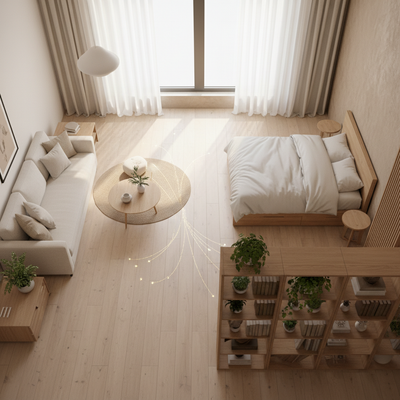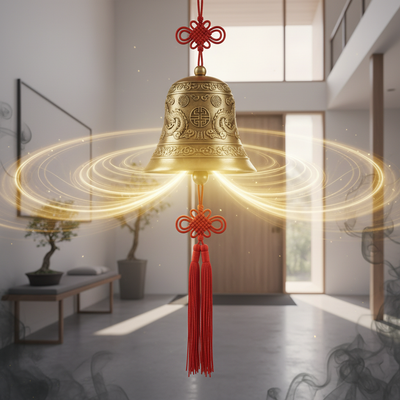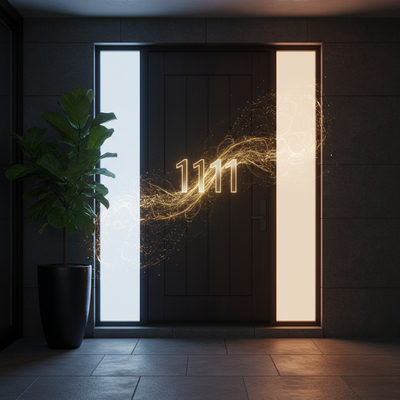Why Where You Put Your Bed Matters
Your bedroom should be a peaceful place where you feel safe and can rest well. But many people have trouble sleeping, wake up tired, or feel uncomfortable in their bedroom without knowing why. Often, the problem is something we don't think about: where we place our bed. In Feng Shui, where and how you position your bed is the most important choice you can make for your whole home. It affects the quality of energy you take in for eight hours every night.
The main rule for this important choice is called the Commanding Position. This isn't just an idea - it's the best spot that directly affects how safe you feel, how much control you have over your life, and the quality of Qi (life energy) you receive during your most vulnerable hours. Getting this right creates the foundation for good sleep and a more powerful life. This guide will teach you everything you need to know about bedroom feng shui bed placement, from the basic rules to practical solutions for even the most difficult room layouts.
The Commanding Position

The Commanding Position is the foundation of bedroom Feng Shui. It is the placement that gives you the greatest sense of safety and energy. Simply put, you are in the Commanding Position when you can see the main door to your bedroom from your bed, but you are not directly in line with it. This placement puts you in control of your space and your life.
The reason behind this rule comes from both ancient wisdom and modern psychology. From a basic human perspective, being able to see the entrance to our "cave" allows our nervous system to relax. When you can't see who or what might be coming into your space, your body stays in a state of low-level alert. This constant watchfulness prevents you from getting the deep, healing sleep you need for physical and mental health. By seeing the door, you remove this hidden stress and tell your brain that you are safe and in control.
From an energy perspective, Qi flows into a room through the door. You want to be in a position to receive this fresh, healthy energy, but not be in its direct path. Think of Qi as a stream of water flowing into the room. You want to be resting in a calm spot beside the stream, not directly in the rushing current. Placing your bed diagonally across from the door allows the Qi to move around, slow down, and gently surround you, rather than hitting you with a force that can feel harsh and disruptive.
To find this position in your room, stand at the doorway and look in. The Commanding Position is usually on the wall that is diagonal to and farthest from the door. Here are the three essential requirements for the perfect spot:
- Your View: You can clearly see the bedroom door while lying in bed.
- Your Position: You are not directly in the path of the door's opening.
- Your Support: You have a solid, strong wall behind your head.
7 Critical Placement Mistakes
Just as important as knowing where to place your bed is knowing where not to place it. Many common bedroom layouts accidentally create poor Feng Shui, which can lead to poor sleep, health problems, and a feeling of being stuck. We've identified the seven most critical bedroom feng shui bed placement mistakes to avoid.
-
The "Coffin Position"
This is the worst placement in Feng Shui. It happens when your feet point directly out the door while you're lying in bed. In terms of energy, this is considered the position of death because it copies how dead people are carried out of a room. While sleeping in this position, your personal Qi is believed to be constantly pulled out of the room, draining your life force night after night. This can lead to constant tiredness, lack of energy, and a sense that your energy and opportunities are always flowing away from you. -
Bed Under a Window
A solid wall behind your head represents support, stability, and protection. A window, by nature, is fragile and open. Placing your bed under a window leaves you without energy support. Qi can easily escape through the window, weakening your personal energy field. Also, the subtle drafts, sounds, and light changes from outside can disturb your subconscious and prevent deep sleep, leading to feelings of insecurity and restlessness. -
Bed Directly in Line with Door
While you want to see the door, you must not be directly in its path. When the bed is aligned with the doorway, you are hit by a direct line of "Sui Qi" - fast-moving, aggressive energy. This constant energy "attack" can be very disruptive to your health and well-being. It's like trying to sleep on a busy highway. This placement is linked to many issues, from difficulty falling asleep to more serious health problems, as your body is in a constant state of defense. -
Bed Against a Bathroom Wall
Bathrooms and toilets are places where energy and water are constantly draining away. When your bed shares a wall with a toilet - especially if your head is against that wall - this draining energy can negatively affect your health and wealth. The plumbing systems carry negative Qi, which can seep through the wall and contaminate your personal energy field while you sleep, leading to loss of energy and financial stability. -
Bed Under a Sloped Ceiling or Beam
Features like exposed beams or sharply sloped ceilings directly above the bed create heavy, oppressive energy. A beam acts like a "cutting" blade, creating constant downward pressure on your energy field. This can show up physically as headaches or a feeling of being weighed down. Emotionally, it can lead to feelings of being oppressed, limited, or divided, especially if the beam runs down the middle of the bed, energetically separating a couple. -
Bed Facing a Mirror
Mirrors are powerful Feng Shui tools that activate and multiply energy. While this can be helpful in other areas of the home, it's counterproductive in a space designed for rest. A mirror facing the bed doubles the activity in the room, potentially leading to insomnia and restlessness. It is also believed that when we sleep, our soul or spirit leaves the body to rest and rejuvenate. A mirror can startle the spirit upon waking, which can be disorienting and unsettling. -
No Room to Breathe
A bed pushed tightly into a corner with both the headboard and one side against a wall restricts the flow of Qi. Energy needs to move freely around your body as you sleep. When it's blocked on one side, it can lead to feelings of being stuck or limited in life. For couples, this can create an imbalance in the relationship, with the person against the wall feeling trapped or less empowered. Ideally, there should be open space on both sides of the bed.
Essential Supporting Elements
Achieving optimal bedroom Feng Shui goes beyond just the bed's location. Several key elements work together with the Commanding Position to create a truly supportive and peaceful environment. Think of these as the essential accessories that complete your sanctuary.
The Importance of a Solid Headboard
Your headboard is more than decoration; it's a critical Feng Shui element. It represents support and stability in your life, connecting you to the solid wall behind you and enhancing the feeling of security. A strong headboard acts as an anchor for your personal energy while you sleep.
We recommend choosing a headboard that is solid and made from natural materials like wood or one that is upholstered. These materials provide a sense of sturdy, gentle support. You should avoid headboards with bars or slats, as they can create a "caged" or "imprisoned" feeling, energetically cutting the energy behind your head and disrupting your sense of peace. The headboard should be securely attached to the bed frame to ensure it doesn't wobble, which can translate into instability in your life.
Creating Balance with Nightstands
Balance is a fundamental concept in Feng Shui, and nowhere is it more important than in the bedroom, a space that often represents partnership. Placing a matching nightstand on each side of the bed is a powerful way to promote balance, equality, and harmony in your relationship. Even if you are single, two nightstands create energetic space and an invitation for a future partner.
These nightstands should ideally be of similar size and height. They act as grounding points on either side of the bed, creating a stable and contained energy field. To maintain this clear, balanced energy, it's crucial to keep your nightstands uncluttered. Reserve them for only a few essential items: a lamp for soft lighting, a book you're currently reading, and perhaps a small, meaningful object.
What's Under the Bed Matters
The space beneath your bed is not just dead space; it's an area where energy needs to flow freely around you as you rest. What you store here directly impacts the quality of your sleep and your subconscious mind.
The best scenario is to have nothing under your bed. This allows Qi to circulate without obstruction, cleansing your energy field throughout the night. If storage is absolutely necessary, the only acceptable items are soft, sleep-related things like spare linens, blankets, or pillows. These items carry neutral or restful energy.

You must avoid storing anything with active, stale, or emotionally charged energy. This includes shoes (which carry the energy of the outside world), old documents, work-related items, and especially anything with emotional baggage, such as letters or photos from past relationships. Storing these items under you is like sleeping on a bed of unresolved issues, which can block your progress in life and disrupt your peace.
Solving Common Layout Challenges
In an ideal world, every bedroom would have a clear and obvious Commanding Position. But in reality, modern architecture often presents us with tricky layouts, small spaces, and immovable features like windows and closets. This is where true Feng Shui expertise comes in - not just knowing the rules, but knowing how to apply cures when the rules can't be followed perfectly.
Problem: Bed Must Be in Line with Door
Sometimes, due to the room's shape, the only logical place for the bed is directly in the path of the door. To reduce the rushing "Sui Qi," you need to diffuse and slow it down. The classic Feng Shui cure is to hang a multi-faceted crystal ball from the ceiling, positioned halfway between the door and your bed. The facets of the crystal will break up the harsh energy, scattering it gently around the room. A simpler, more decorative solution is to place a piece of furniture at the foot of your bed, such as an upholstered bench, an ottoman, or a low chest. This object acts as a physical and energetic buffer, absorbing the initial force of the incoming Qi before it reaches you.
Problem: The Only Wall Has a Window
This is a frequent issue we encounter. At THE QI FLOW, when our team helps a client with a challenging bedroom feng shui bed placement, this is a common scenario. Placing a bed under a window compromises your energetic support system. To remedy this, the first step is to create a "surrogate wall." We advise using a very strong, solid, and tall headboard. The headboard should be as substantial as possible to create a visual and energetic sense of a solid wall behind you. The second layer of this cure involves the window treatment. Install heavy, thick, opaque curtains or a solid blackout blind. It is crucial to keep these drawn closed every night to provide an extra layer of energetic protection, block out external disturbances, and create the feeling of a secure wall.
Problem: A Mirror Faces the Bed
If you have a closet with mirrored doors or a dresser with an attached mirror that you cannot move, it will activate the energy in the room and can disrupt your sleep. The simplest and most effective cure is to simply cover it at night. You can use a beautiful piece of fabric, a decorative scarf, or a purpose-built standing screen. The act of covering the mirror before sleep symbolically "turns off" its activating energy, allowing the room's Qi to settle into a calm, yin state conducive to rest.
| Problem | Primary Solution | Secondary Solution |
|---|---|---|
| Bed must be under a window | Use a very solid, tall headboard | Install heavy, opaque curtains and keep them closed at night |
| Bed must be in line with door | Hang a faceted crystal ball between door & bed | Place a footboard or bench at the end of the bed |
| Bed must face a mirror | Cover the mirror with a cloth at night | Reposition the mirror or replace it with art |
A 5-Step Application Guide
Reading about Feng Shui is one thing; applying it is another. To help you translate this knowledge into real results, we've created a simple, five-step process. This active guide will help you assess your own room and confidently make the changes needed to improve your sleep and well-being. Grab a pen and paper or open the notes app on your phone, and let's begin.
-
Step 1: Sketch Your Room's Blueprint
Start by drawing a simple, top-down view of your bedroom's layout. Don't worry about making it perfectly to scale. The goal is to have a clear visual reference. Be sure to mark the location of the main door (and any other doors, like to a closet or bathroom), all windows, and any significant built-in features like a fireplace or permanent shelving. This sketch is your map. -
Step 2: Identify All Potential Bed Walls
Look at your blueprint. Identify every solid wall where you could potentially place the head of your bed. A "solid wall" is one without any doors or windows. Mark these potential walls on your sketch. In some rooms, you may have three or four options; in others, you might only have one or two. This step clarifies your available choices. -
Step 3: Find the Commanding Position
Now, evaluate each potential wall from Step 2. Stand in the position of the bed for each option and ask yourself: "Can I see the main bedroom door from here without being directly in its path?" The wall that allows you to see the door diagonally is your prime candidate for the Commanding Position. Circle this spot on your sketch. This is your ideal placement, your "Plan A." -
Step 4: Cross-Reference with the "Don'ts"
Take your "Plan A" and check it against our list of the 7 critical mistakes. Is this spot under a sloped ceiling or an exposed beam? Is it on a shared wall with a toilet? Does it force the bed to face a large mirror? If your ideal Commanding Position is free of all these issues, you've found the perfect spot. If it does have a conflict, don't worry. Note the specific issue and proceed to the next step. If the conflicts are major, consider your second-best wall option and evaluate that one as well. -
Step 5: Plan Your Move & The Cures
This is the action step. If your chosen spot is clear of all "Don'ts," you can confidently plan the physical move. If your best available position has an unavoidable issue (like being under a window or in line with the door), refer back to our "Solving Real-World Challenges" section. Decide which cure you need to implement. Do you need to buy a sturdier headboard? Hang a crystal? Find a beautiful cloth to cover a mirror? Write down a concrete plan and commit to making the change. This final step transforms your intention into a positive reality.
Finishing Touches for Good Energy
Once your bed is in its optimal position, you can amplify the positive energy in your sanctuary with a few simple, finishing touches. These adjustments help to calm the environment and support the restful Qi you've cultivated.
- Declutter Completely: Clutter is the physical manifestation of stagnant energy. A clear, organized room is essential for a clear mind and restful sleep. Remove anything that doesn't belong in a sanctuary of rest.
- Incorporate Soft Lighting: Harsh, overhead lighting is jarring and overly "yang" for a bedroom. Use lamps with warm-toned bulbs on your nightstands or in the corners of the room to create a soft, calming, and "yin" ambiance in the evening.
- Choose Soothing Colors: Your bedroom's color palette has a significant impact on your mood. Opt for colors that are soothing and nurturing. Earth tones, soft neutrals, and muted pastels that mimic skin tones are all excellent choices for promoting relaxation.
- Limit Electronics: The bedroom should be a low-tech zone. The electromagnetic fields (EMFs) and blue light from TVs, computers, and phones are highly activating and can severely disrupt sleep patterns. If you must have them, keep them as far from the bed as possible and turn them completely off at night.
Take Command of Your Rest
By now, you understand that your bed's placement is not a trivial decorating choice - it is a powerful act of self-care. Optimizing your bedroom's layout is one of the most impactful changes you can make to improve your daily energy, health, and overall sense of well-being.
Let's recap the most vital takeaways. First, always prioritize the Commanding Position, as it is the foundation for security and restorative rest. Second, be vigilant in avoiding the critical "Don'ts," like the coffin position or placing your bed under a window, which can actively drain your energy. And finally, remember that for nearly every architectural challenge, a practical and effective Feng Shui solution exists.
By taking the time to assess and adjust your space, you are no longer a passive occupant of your room; you are the active creator of your sanctuary. When you optimize your bedroom feng shui bed placement, you are taking a decisive step toward deeper sleep, better health, and a life lived with greater harmony and command.







